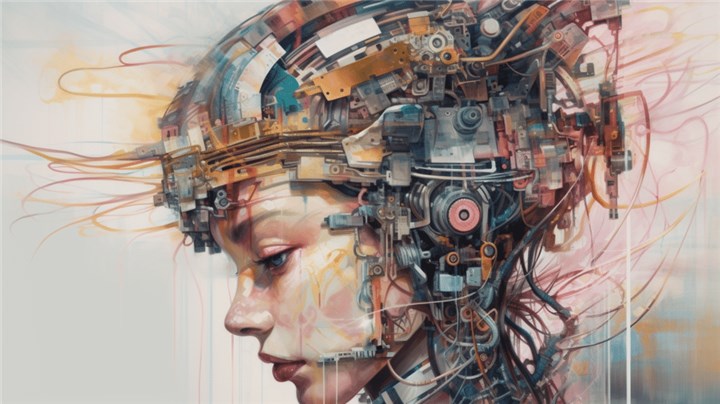Creating compelling AI art prompts is both an art and a science. Whether you're a seasoned marketer, a content creator, or just someone curious about the world of AI-generated art, this guide will equip you with the knowledge and techniques to craft prompts that yield stunning visual results. Let's dive in!
I. Understanding AI Art Generators
Before we delve into writing prompts, let's grasp the basics of how AI art generators work. These tools are not human artists; they rely on patterns and relationships within their training data. Keep in mind that they don't inherently understand concepts like beauty or emotion. Instead, they respond to specific features and instructions.
One of the key components of AI art generators is the use of neural networks. These networks are designed to mimic the way the human brain processes information. By using layers of interconnected nodes, neural networks are able to learn and recognize patterns in large sets of data. In the case of AI art generators, these networks learn from vast collections of existing artwork to create new and unique visuals.
When using AI art generators, it's important to understand that they respond better to specific features rather than abstract concepts. Instead of asking the AI to create a "beautiful" or "emotional" piece of art, it's more effective to specify features like symmetry, color, or texture. By providing clear instructions on the desired features, you can guide the AI towards creating the kind of art you have in mind.
To get the best results from AI art generators, it's crucial to provide detailed and clear instructions. The more specific you are with your prompts, the more likely the AI will be able to generate the desired output. For example, instead of simply saying "draw a landscape," you could specify details like "draw a colorful sunset over a mountain range with a flowing river in the foreground." The more information you provide, the more accurate and tailored the AI's response will be.

II. How to Craft Effective AI Art Prompts
Now, let's delve into the essential components of a successful AI art prompt, helping you unleash your creativity and produce captivating AI-generated masterpieces.
1. Setting the Scene
When crafting an AI art prompt, it's essential to provide a clear and vivid description of the image you desire. The more detailed and specific you are, the better the AI algorithm can understand and interpret your vision. Here are a few tips to consider:
1. Be Descriptive: Imagine yourself describing the image to a friend who can't see it. Use language that paints a picture in their mind. For example, instead of saying "a mountain landscape," try "a serene mountain landscape at sunset, with snow-capped peaks, warm orange hues, and misty valleys."
2. Specific Details: The devil is in the details, and the same goes for AI art prompts. Include specific elements such as shapes, colors, textures, and patterns that you want to see in the image. This helps the AI model to generate a more accurate representation of your vision.
2. Shaping the Artistic Expression
To ensure that the AI-generated artwork aligns with your artistic preferences, it's crucial to specify the art form, style, and provide references for inspiration. Here's how to do it:
1. Specify Art Form: Are you looking for an abstract painting or a photorealistic portrait? Clearly stating the desired art form will guide the AI algorithm in generating the appropriate style.
2. Artistic Style: Determine the artistic style you want the AI algorithm to follow. Whether it's impressionist, minimalist, or any other style, be explicit in your prompt.
3. Artist References: If you have specific artists whose work resonates with your vision, mention them in your prompt. This helps the AI algorithm understand your aesthetic preferences and generate artwork that reflects those influences.
3. Setting the Mood and Composition
To add depth and atmosphere to your AI-generated artwork, consider incorporating additional settings such as lighting, mood, color palette, and framing. Here's how to go about it:
1. Lighting and Mood: Describe the desired lighting conditions and mood you want to convey in the artwork. Do you envision soft, diffused light or an eerie ambiance? These details help the AI algorithm create the desired atmosphere.
2. Color Palette: Specify the dominant colors you want to see in the artwork. This helps the AI algorithm focus on generating the hues that align with your artistic vision.
3. Framing: Consider the composition of the artwork. Do you want a close-up shot or a panoramic view? By describing the framing, you guide the AI algorithm in generating the desired composition.
Remember, the more detailed and specific you are in your prompt, the better the AI algorithm can understand and bring your artistic vision to life.
III. More Tips for Writing Effective AI Art Prompts
1. Keep it Concise: The Power of Short Prompts
When it comes to AI art prompts, brevity is key. Keeping your prompts short, typically between 3 to 7 words, can yield better results. AI models are more likely to generate interesting and creative responses when provided with concise prompts. So, instead of writing a lengthy sentence, try condensing your idea into a few impactful words.
2. Be Specific: The Importance of Concrete Language
Concrete language is crucial when crafting AI art prompts. Using vivid and specific terms helps guide the AI model in generating more accurate and detailed responses. For example, instead of a generic prompt like "paint a landscape," try something more specific like "create a vibrant sunset scene over the ocean." The more precise your language, the better the AI model can understand and interpret your vision.
3. Experiment and Test: Finding the Perfect Prompt
Every AI model has its own quirks and preferences. To find the perfect prompt that resonates with a particular AI art generator, it's important to experiment and test different prompts. Try out various combinations of words and phrases, and observe how the AI model responds. By iterating and refining your prompts, you can discover the sweet spot that sparks the most interesting and unique AI-generated art.
4. Learn from Examples: Exploring AI Art Generators
One of the best ways to improve your AI art prompt skills is to explore existing AI art generators and observe their responses. Take a deep dive into the world of AI-generated art and see how different prompts elicit different creative outputs. By studying these examples, you can gain insights into what works well and what doesn't, and apply those learnings to your own prompt creation process.
5. Try to Avoid Some Common Mistakes in AI Art Prompts
Mistake 1: Vagueness. Being too vague or broad in your AI art prompt can lead to generic or irrelevant responses from the model. Instead, it's crucial to be specific and descriptive about what you want to see in the image. By providing clear instructions, you can guide the AI model towards producing the desired outcome.
For example, instead of saying "Draw a landscape," try something like "Create a vibrant sunset over a mountain range, with shades of purple and orange casting long shadows on the valley below."
Mistake 2: Over-Specification. While it's important to be specific, excessively detailed prompts can confuse the AI model or limit its creative scope. It's essential to strike a balance between specificity and room for interpretation to encourage artistic freedom.
For instance, avoid providing every minute detail and allow the AI model to explore various possibilities. A prompt like "Design a futuristic cityscape with towering skyscrapers and flying cars" leaves room for the AI model to experiment and create unique interpretations.
Mistake 3: Ignoring Context. Failing to consider the context or background information can result in unexpected and undesired outcomes. Always provide relevant context to guide the AI model effectively. This can include information about the desired style, theme, or any specific elements you want to be incorporated.
For instance, if you want the AI model to create a portrait of a historical figure, provide details about their appearance, clothing, and background to ensure accuracy and relevance.
Conclusion
By incorporating these subtopics, our guide will equip writers with a deeper understanding of AI art prompts. Remember, clarity, specificity, and experimentation are key. Now go forth and inspire AI-generated masterpieces!




